An Analytical Solution for Effect of Magnetic Field and Initial Stress on an Infinite Generalized Thermoelastic Rotating Nonhomogeneous Diffusion Medium
Abstract
The problem of generalized magneto-thermoelastic diffusion in an infinite rotating nonhomogeneity medium subjected to certain boundary conditions is studied. The chemical potential is also assumed to be a known function of time at the boundary of the cavity. The analytical expressions for the displacements, stresses, temperature, concentration, and chemical potential are obtained. Comparison was made between the results obtained in the presence and absence of diffusion. The results indicate that the effect of nonhomogeneity, rotation, magnetic field, relaxation time, and diffusion is very pronounced.
1. Introduction
Diffusion can be defined as the spontaneous migration of substances from regions of high concentration to regions of low concentration. There is now a great deal of interest in the study of this phenomenon due to its many applications in geophysics and industrial applications. Thermodiffusion in the solids is one of the transport processes which has great practical importance. Thermodiffusion in an elastic solid is due to the coupling of the fields of temperature, mass diffusion, and that of strain. This mater has attracted the attention of many researchers such as [1–5]. Wave propagation in rotating and nonhomogeneous media was studied by Abd-Alla et al. [6–8]. The extended thermoelasticity theory, introducing one relaxation time in the thermoelastic process, was proposed by Lord and Shulman [9]. In this theory, a modified law of heat conduction including both the heat flux and its time derivative replaces conventional Fourier’s law. The heat equation associated with this is a hyperbolic one and hence automatically eliminates the paradox of infinite speeds of propagation inherent in the coupled theory of thermoelasticity. This theory was extended by Dhaliwal and Sherief [10] to include the anisotropic case. Abd-Alla and Mahmoud [11] investigated the magneto-thermoelastic problem in rotating nonhomogeneous orthotropic hollow cylinder under the hyperbolic heat conduction model. Mahmoud [12] investigated wave propagation in cylindrical poroelastic dry bones.
Kumar and Devi [13] studied deformation in porous thermoelastic material with temperature dependent properties. Othman et al. [14] presented the study of the two-dimensional problems of generalized thermoelasticity with one relaxation time with the modulus of elasticity being dependent on the reference temperature for nonrotating and rotating medium, respectively. Kumar and Gupta [15] investigated deformation due to inclined load in an orthotropic micropolar thermoelastic medium with two relaxation times. The temperature-rate dependent theory of thermoelasticity, which takes into account two relaxation times, was developed by Green and Lindsay [16]. Abd-Alla et al. [17, 18] investigated radial vibrations in a nonhomogeneous orthotropic elastic medium subjected to rotation and gravity field. Sherief et al. [19] developed the generalized theory of thermoelastic diffusion with one relaxation time, which allows the finite speed of propagation waves. Sherief and Saleh [20] investigated the problem of a thermoelastic half-space in the context of the theory of generalized thermoelastic diffusion with one relaxation time. The reflection of SV waves from the free surface of an elastic solid in generalized thermoelastic diffusion was discussed by Singh [21]. Kumar and Kansal [22] discussed the propagation of Lamb waves in transversely isotropic thermoelastic diffusive plates. Thermomechanical response of generalized thermoelastic diffusion with one relaxation time due to time harmonic sources was discussed by Ram et al. [23]. Aouadi [24] examined the thermoelastic diffusion problem for an infinite elastic body with spherical cavity. Abd-Alla and Mahmoud [25] investigated analytical solution of wave propagation in nonhomogeneous orthotropic rotating elastic media. Othman et al. [26] discussed the effect of diffusion in a two-dimensional problem of generalized thermoelasticity with Green-Naghdi theory. Xia et al. [27] studied the influence of diffusion on generalized thermoelastic problems of infinite body with a cylindrical cavity. Deswal and Kalkal [28] studied the two-dimensional generalized electromagneto-thermoviscoelastic problem for a half-space with diffusion. Abd-Alla and Abo-Dahab [29] found the time-harmonic sources in a generalized magneto-thermo-viscoelastic continuum with and without energy dissipation. Mahmoud [30] discussed influence of rotation and generalized magnetothermoelastic on Rayleigh waves in a granular medium under effect of initial stress and gravity field. Abd-Alla et al. [31, 32] studied the generalized magneto-thermoelastic Rayleigh waves in a granular medium under the influence of a gravity field and initial stress.
In the present investigation, the temperature, displacements, stresses, diffusion, and concentration as well as chemical potential are obtained in the physical domain using the harmonic vibrations. Also, study of the interaction between the processes of elasticity, nonhomogeneity, rotation, magnetic field, initial stress, heat, and diffusion in an infinite elastic solid with a spherical cavity in the context of the theory of generalized thermoelastic diffusion is presented.
2. Formulation of the Problem
3. Dimensionless Quantities
4. Boundary Conditions
5. Solution of the Problem
where e = (∂u/∂r) + (2u/r) = (1/r2)(∂/∂r)(r2u).
6. Particular Case
7. Numerical Results and Discussion

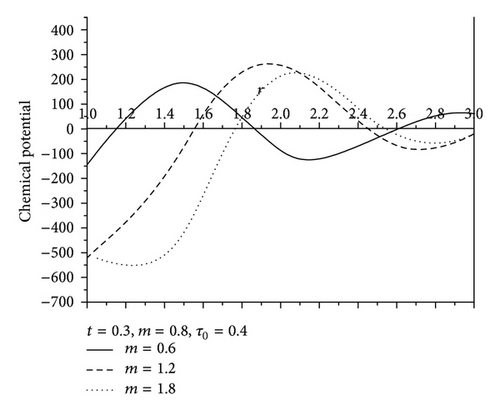
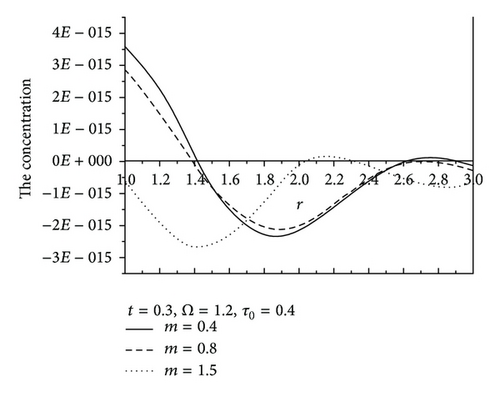
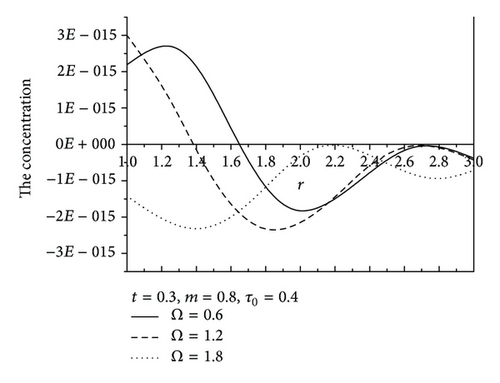
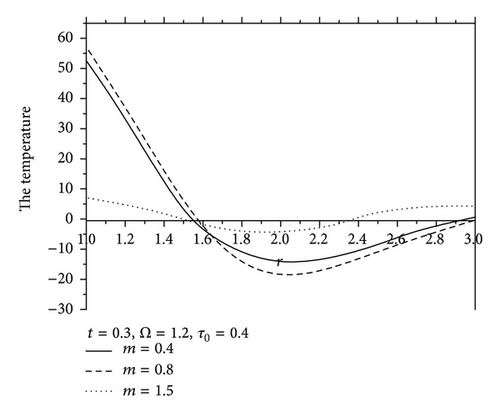
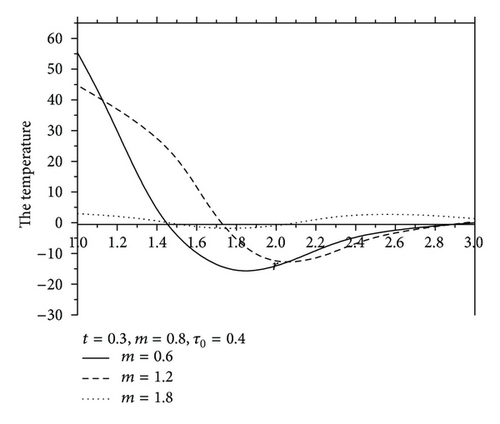
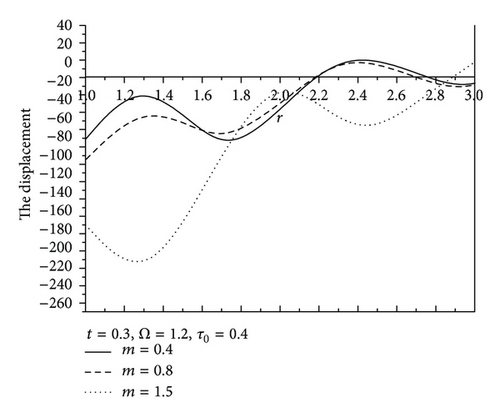
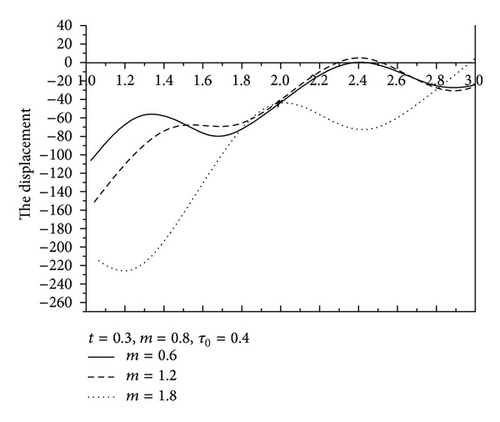
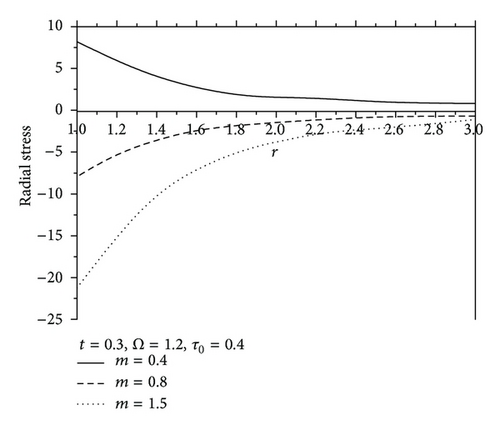

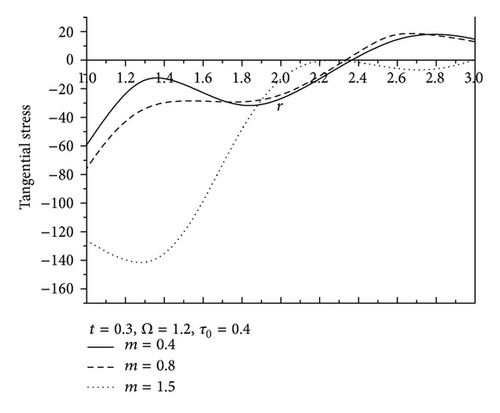
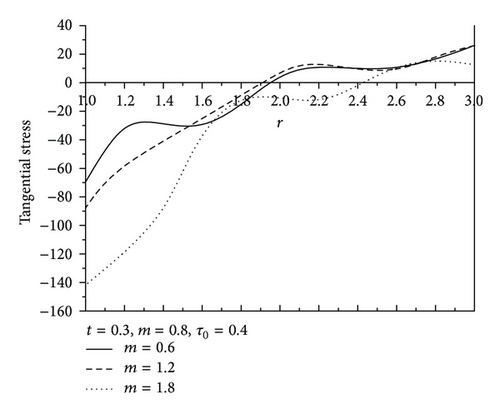
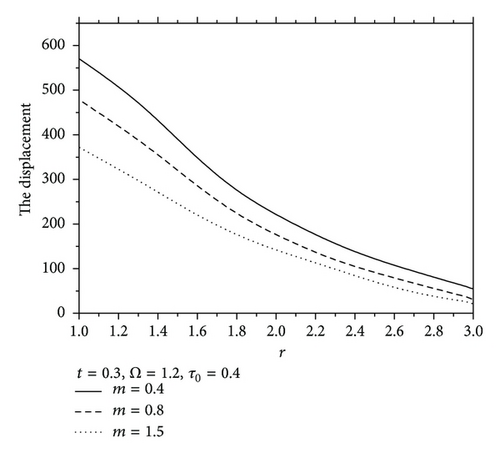
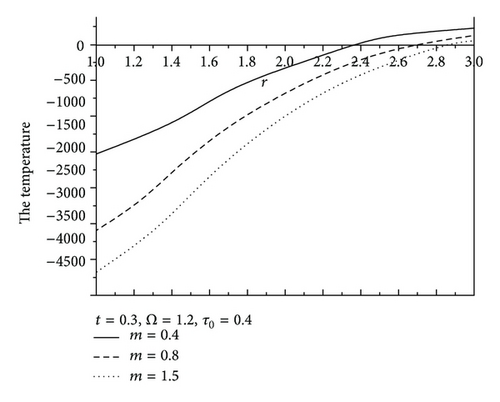
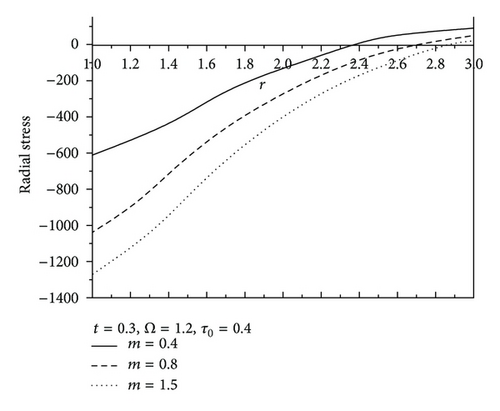
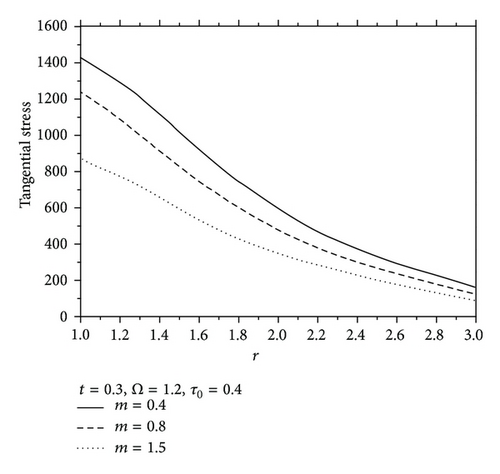
Figure 7 shows the values of radial displacement u in thermoelastic medium without diffusion. This figure indicates clearly that the radial displacement at the cavity surface tends to zero which agrees with the boundary conditions prescribed. This coincides with the mechanical boundary condition of the cavity, in case of fixed surface. Figure 8 shows the values of temperature distribution θ without diffusion in the whole range of radius r. It was found that the values of θ under effect of nonhomogeneity and rotation Ω are increase with an increase of nonhomogeneity and rotation Ω but are decreasing with the increase of the values of m. Figures 9 and 10 show the values of radial stress σrr and the tangential stress σϕϕ without diffusion in the whole range of radius r, respectively. It was found that the values of σrr under the effects of nonhomogeneity m and rotation Ω are increasing with an increase of the values of nonhomogeneity m and rotation Ω, while the values of σrr are decreasing with an increase of nonhomogeneity m, while the tangential stress σϕϕ is decreasing with the increase of the values of nonhomogeneity m and rotation Ω, but the values of σϕϕ are increasing with an increase of m. Due to the complicated nature of the governing equations of the generalized magneto-thermoelastic diffusion theory, the done works in this field are unfortunately limited. The method used in this study provides quite a success in dealing with such problems. This method gives exact solutions in the elastic medium without any restrictions on the actual physical quantities that appear in the governing equations of the considered problem.
8. Conclusions
The results presented in this paper will be very helpful for researchers concerned with material science, designers of new materials, and low-temperature physicists, as well as for those working on the development of a theory of hyperbolic propagation of hyperbolic thermodiffusion. Study of the phenomenon of nonhomogeneity, rotation, magnetic field, and diffusion is also used to improve the conditions of oil extractions. It was found that, for values of rotation and nonhomogeneity, the coupled theory and the generalization give close results. The case is quite different when we consider small value of rotation and nonhomogeneity. Comparing Figures 1–6 in case of thermoelastic diffusion medium with the Figures 7–10 in case of thermoelastic medium, it was found that u, σrr, σϕϕ, C, and P have the same behavior in both media. But with the passage of nonhomogeneity and rotation, the numerical values of u, σrr, σϕϕ, C, and P in thermoelastic diffusion medium are large in comparison with those in thermoelastic medium due to the influences of nonhomogeneity, magnetic field, rotation, and mass diffusion.
Acknowledgment
This article was funded by the Deanship of Scientific Research (DSR), King Abdulaziz University, Jeddah. The author, therefore, acknowledge with thanks DSR technical and financial support.




